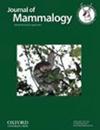Ecological niche modeling of the Leopardus tigrinus complex sheds light on its elusive evolutionary history
IF 1.5
3区 生物学
Q2 ZOOLOGY
引用次数: 0
Abstract
The evolutionary history and taxonomy of the Leopardus tigrinus species complex have been studied based on several approaches, mostly employing genetic and morphological data, leading to distinct classification schemes. We approached this problem from an ecological perspective, with 2 main goals: (i) to evaluate ecological niche differences among regional L. tigrinus populations to determine the extent of ecological divergence among them; and (ii) to identify environmental barriers to historical dispersal that could have driven differentiation among the proposed groups. We modeled the ecological niche of all taxonomic/geographic groups proposed so far to comprise the L. tigrinus complex using the Maximum Entropy algorithm, and evaluated geographic and ecological niche differences among them. Furthermore, we investigated possible environmental barriers to historical dispersal that could have driven differentiation among regional groups. We evaluated 4 hypothetical barriers across 3 time periods to assess their potential historical effect. We found high ecological divergence between northeastern tigrina populations and the northern Andean and Central American tigrinas. Other groups within the L. tigrinus complex are less divergent. In addition, the Guiana Shield tigrina, where the type locality of the species is located, seems to be ecologically similar to populations from northeastern Brazil while also showing some overlap with Andean populations. The Panama center, the Llanos of Colombia and Venezuela, and the Amazon region were identified as historical barriers for tigrina dispersal across all time periods. The inferred historical barriers and ecological divergence observed in this study contribute to the inference of evolutionary differentiation among geographic groups comprising the L. tigrinus complex, revealing areas of consistently low habitat suitability that have likely contributed to divergence among regional populations.豹纹虎复合体的生态位建模揭示了其难以捉摸的进化史
豹纹虎科物种群的进化史和分类学研究基于多种方法,大多采用遗传学和形态学数据,从而形成了不同的分类方案。我们从生态学的角度来研究这个问题,主要有两个目标:(i) 评估各地区虎斑猫科动物种群之间的生态位差异,以确定它们之间的生态分化程度;(ii) 识别可能导致拟议种群之间分化的历史扩散环境障碍。我们利用最大熵算法对迄今为止提出的所有构成虎纹蛙复合种群的分类/地理类群的生态位进行了建模,并评估了它们之间的地理和生态位差异。此外,我们还研究了历史上可能存在的环境扩散障碍,这些障碍可能会导致区域组之间的分化。我们评估了 3 个时期的 4 个假定障碍,以评估其潜在的历史影响。我们发现东北虎纹蛙种群与安第斯山脉北部和中美洲虎纹蛙种群之间的生态差异很大。虎纹蛙复合种群中的其他种群之间的差异较小。此外,该物种模式产地所在的圭亚那地盾虎纹鹦鹉在生态学上似乎与巴西东北部的种群相似,同时也与安第斯种群有一些重叠。巴拿马中心、哥伦比亚和委内瑞拉的Llanos以及亚马逊地区被认为是虎纹蛙在各个时期扩散的历史障碍。本研究中观察到的历史障碍和生态分化推断有助于推断虎纹蛙复合种群地理群落之间的进化分化,揭示了栖息地适宜性持续较低的地区,这些地区很可能导致了区域种群之间的分化。
本文章由计算机程序翻译,如有差异,请以英文原文为准。
求助全文
约1分钟内获得全文
求助全文
来源期刊

Journal of Mammalogy
生物-动物学
CiteScore
3.30
自引率
5.90%
发文量
106
审稿时长
4-8 weeks
期刊介绍:
Papers are published on mammalian behavior, conservation, ecology, genetics, morphology, physiology, and taxonomy.
 求助内容:
求助内容: 应助结果提醒方式:
应助结果提醒方式:


